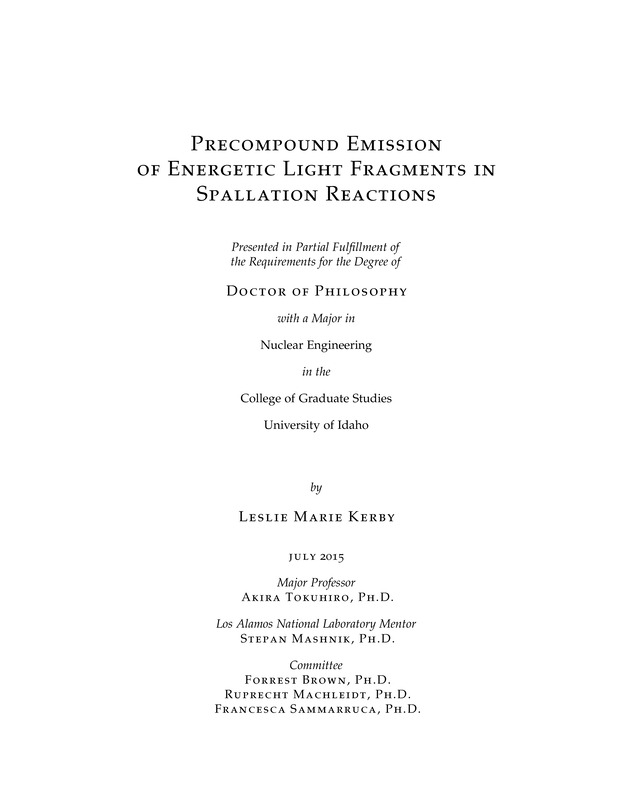Precompound Emission of Energetic Light Fragments in Spallation Reactions
Kerby, Leslie Marie. (2015). Precompound Emission of Energetic Light Fragments in Spallation Reactions. Theses and Dissertations Collection, University of Idaho Library Digital Collections. https://www.lib.uidaho.edu/digital/etd/items/kerby_idaho_0089e_10662.html
- Title:
- Precompound Emission of Energetic Light Fragments in Spallation Reactions
- Author:
- Kerby, Leslie Marie
- Date:
- 2015
- Keywords:
- CEM Heavy Clusters Light Fragments MCNP6 Nuclear Reactions Spallation Reactions
- Program:
- Mechanical Engineering
- Subject Category:
- Nuclear engineering; Nuclear physics and radiation; Computer science
- Abstract:
-
Emission of light fragments (LF) from nuclear reactions is an open question. Different reaction mechanisms contribute to their production; the relative roles of each, and how they change with incident energy, mass number of the target, and the type and emission energy of the fragments is not completely understood.
None of the available models are able to accurately predict emission of LF from arbitrary reactions. However, the ability to describe production of LF (especially at energies $\gtrsim 30$~MeV) from many reactions is important for different applications, such as cosmic-ray-induced Single Event Upsets (SEUs), radiation protection, and cancer therapy with proton and heavy-ion beams, to name just a few. The Cascade-Exciton Model (CEM) version 03.03 and the Los Alamos version of the Quark-Gluon String Model (LAQGSM) version 03.03 event generators in Monte Carlo N-Particle Transport Code version 6 (MCNP6) describe quite well the spectra of fragments with sizes up to $^{4}$He across a broad range of target masses and incident energies (up to $\sim 5$~GeV for CEM and up to $\sim 1$~TeV/A for LAQGSM). However, they do not predict the high-energy tails of LF spectra heavier than $^4$He well. Most LF with energies above several tens of MeV are emitted during the precompound stage of a reaction. The current versions of the CEM and LAQGSM event generators do not account for precompound emission of LF larger than $^{4}$He.
The aim of our work is to extend the precompound model in them to include such processes, leading to an increase of predictive power of LF-production in MCNP6. This entails upgrading the Modified Exciton Model currently used at the preequilibrium stage in CEM and LAQGSM. It also includes expansion and examination of the coalescence and Fermi break-up models used in the precompound stages of spallation reactions within CEM and LAQGSM. Extending our models to include emission of fragments heavier than $^4$He at the precompound stage has indeed provided results that have much better agreement with experimental data.
- Description:
- doctoral, Ph.D., Mechanical Engineering -- University of Idaho - College of Graduate Studies, 2015
- Major Professor:
- Tokuhiro, Akira
- Committee:
- Mashnik, Stepan; Brown, Forrest; Machleidt, Ruprecht; Sammarruca, Francesca
- Defense Date:
- 2015
- Identifier:
- Kerby_idaho_0089E_10662
- Type:
- Text
- Format Original:
- Format:
- application/pdf
- Rights:
- In Copyright - Educational Use Permitted. For more information, please contact University of Idaho Library Special Collections and Archives Department at libspec@uidaho.edu.
- Standardized Rights:
- http://rightsstatements.org/vocab/InC-EDU/1.0/

